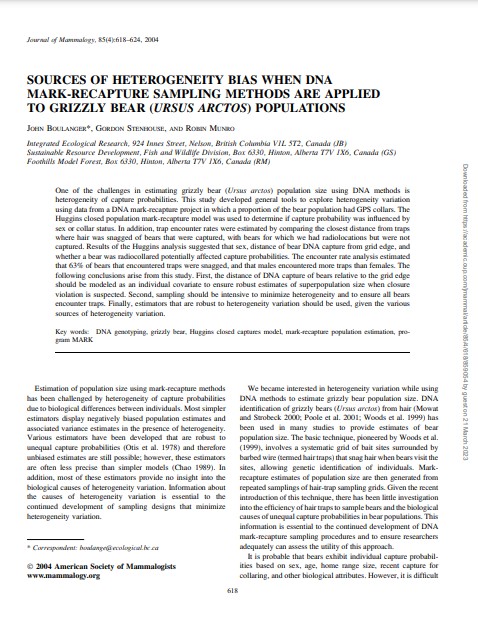Sources of Heterogeneity Bias when DNA Mark-recapture Sampling Methods are Applied to Grizzly Bear (Ursus arctos) Populations
Bosque Modelo:
Foothills
Temática:
Conservación
Tipo de documento:
Artículo científico
Resumen
One of the challenges in estimating grizzly bear (Ursus arctos) population size using DNA methods is heterogeneity of capture probabilities. This study developed general tools to explore heterogeneity variation using data from a DNA mark-recapture project in which a proportion of the bear population had GPS collars. The Huggins closed population mark-recapture model was used to determine if capture probability was influenced by sex or collar status. In addition, trap encounter rates were estimated by comparing the closest distance from traps where hair was snagged of bears that were captured, with bears for which we had radiolocations but were not captured. Results of the Huggins analysis suggested that sex, distance of bear DNA capture from grid edge, and whether a bear was radiocollared potentially affected capture probabilities. The encounter rate analysis estimated that 63% of bears that encountered traps were snagged, and that males encountered more traps than females. The following conclusions arise from this study. First, the distance of DNA capture of bears relative to the grid edge should be modeled as an individual covariate to ensure robust estimates of superpopulation size when closure violation is suspected. Second, sampling should be intensive to minimize heterogeneity and to ensure all bears encounter traps. Finally, estimators that are robust to heterogeneity variation should be used, given the various sources of heterogeneity variation.
Información Bibliográfica
Autor:
Boulanger, J, G Stenhouse and R Munro.
Revista:
Journal of Mammalogy
Año:
2004
N°:
4
País :
Canadá
Páginas:
618 - 624
Volumen:
85
Idioma:
Ingles
Palabras claves
DNA genotyping, grizzly bear, Huggins closed captures model, mark-recapture population estimation, program MARK





